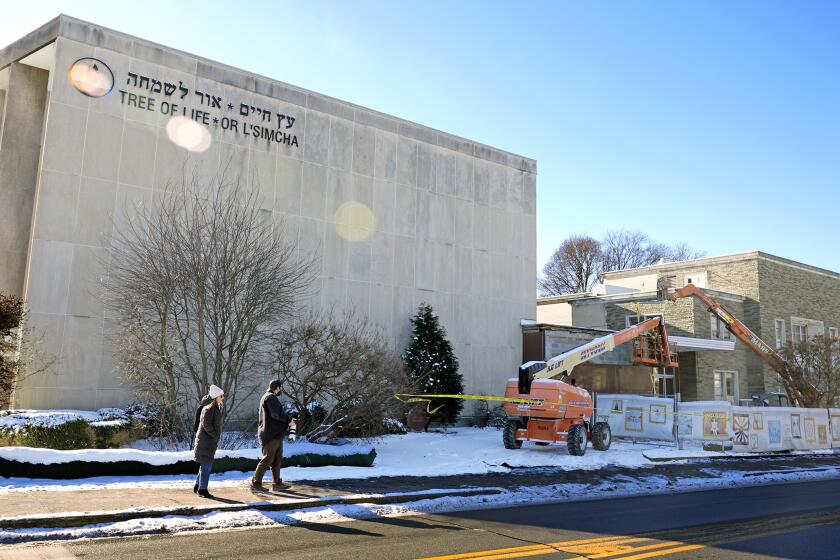White Inmates Fear Further Attacks at Jail : King verdict: Racial segregation imposed after rioting at the Pitchess Honor Rancho is ending. One group pleads to be kept apart from blacks and Latinos.
With the temporary segregation of prisoners at a racially tense county jail ending this week, white inmates say they fear that a spate of attacks by blacks touched off by the not-guilty verdicts in the Rodney King beating case will start again.
Whites represent less than 13% of the nearly 10,000 inmates housed at the Peter J. Pitchess Honor Rancho near Castaic, where the worst jail rioting in the county broke out a few hours after the not-guilty verdicts were announced. The black-against-white fights, the most serious of which involved 1,000 inmates, were markedly different from past brawls, most of which have evolved from a power struggle between blacks and Latinos.
Still nursing wounds from the attacks that led to their segregation nearly two weeks ago, white inmates interviewed this week offered the first in-depth glimpse of the violence that erupted on the night news of the verdicts reached them.
They said tensions rose, and within a few hours the violence inside sections of the jail began mirroring the riots on the streets of Los Angeles. White inmates in the South Facility said they were jumped by up to 50 black inmates brandishing broom handles like billy clubs. One white inmate was wrapped in a burning blanket. Another was slashed by razor wire as he scaled a fence to escape his attackers.
After the fight at the jail’s South Facility, 180 white inmates housed there were segregated for their own protection in two dormitories at another of the five facilities on the Pitchess grounds. Beginning Tuesday night and continuing Wednesday this week, those inmates were re-integrated into the jail population.
“We feel it’s quieted down, and it’s safe to return them to the regular population now,” said Deputy George Ducoulombier of the Sheriff’s Information Bureau.
But white inmates said they are still in danger. As proof, they point to an incident Monday night elsewhere in the jail in which a white inmate was beaten by seven blacks and one Latino. Jail deputies said that assault began with an argument over the King case.
“It’s never been that I was in fear for my life before,” said inmate Johnny Furman, 27, who has been in and out of jail on drug charges for the past seven years. “I’m no wimp, but it’s not fair to integrate us. The white guys ain’t got a chance.”
Sheriff’s officials reported that 64 race-related fights have been logged in the county’s jails since the April 29 verdicts, but they said most of those incidents involved only a few inmates. The outbreak at Pitchess’ South Facility, which resulted in 30 injuries and drove deputies out of the dormitories for half an hour, was by far the largest incident and led to the only move to segregate prisoners, Ducoulombier said.
White inmates who were inside the South Facility that night recalled that, minutes after news of the verdicts reached the jail, through telephone conversations with friends and relatives, all eyes suddenly turned on them. “Let’s get the ‘woods,” black prisoners reportedly shouted, using the jail slang term for whites.
“I was hit with a broom handle six to seven times in the forehead, then I was banged four to five times in the back of the head with a radio,” said Michael Tray Johns, 28, in jail for drug possession. “I was almost knocked unconscious, but I knew, if I went out, they were going to kill me.”
Thirty minutes passed before deputies dressed in riot gear and armed with tear gas and rubber bullets were able to re-enter the dormitory and quell the violence.
After their wounds were treated, the white inmates were moved to white-only dormitories at the North Facility, where they said relative calm has prevailed for the past two weeks. But because segregation is against federal law, jail deputies were told late last week to begin re-integrating the whites into the general prison population.
The complete segregation in the two white dormitories in the North Facility was broken Tuesday night, but whites remain in the majority in each of them. Told that they would be gradually moved back into the main jail population, a group of white inmates composed a letter pleading to be allowed to remain segregated.
“We . . . formally express our collective doubt about the ability of the Los Angeles Sheriff’s Department to assure our safety . . . in the event of the impending reintroduction into the main population,” they wrote.
In the letter, they said they would only return to the South Facility “under protest for fear of our life and limb.”
In interviews, inmates characterized that dormitory as the jail equivalent of the intersection of Florence and Normandie avenues, where in the first hour of rioting, motorists were dragged from their vehicles and beaten.
In defense of their plea for continued segregation, the inmates point out that, because of their intense rivalry, Crips and Bloods are routinely separated in Los Angeles County jails. They also mention that, for their protection, blacks are grouped together--though mixed in dorms with prisoners of other races--in Orange County jails, where they are in the minority.
Inmate advocates shun total segregation but support grouping prisoners by race to make them less vulnerable. Dick Herman, a member of the state Prisoners’ Rights Union board and a Newport Beach attorney, said the major problem with segregation is that “separate but equal is never really equal.”
However, Malcolm Klein, a sociology professor at the University of Southern California who is familiar with Pitchess, said even grouping the white inmates together in mixed-race dormitories is risky.
“If you put too many whites against too many blacks, they may take the offensive and decide they can start things,” he said.
Indeed, by midday Wednesday, some of the white inmates were talking of retaliation.
Retaliation “doesn’t sound like a good idea to me, but the more I hear, the more I think maybe it’s the only way,” said inmate Simon Freeman, 24. “I’ve become very racial and prejudiced in here. I’m sorry to say that. It’s gotten me bitter.”
Jail scholars have long said that the large dormitory-style accommodations at Pitchess make fighting among groups more likely there than at the county’s three other jails. Up to 130 inmates are housed together at Pitchess, sleeping on bunk beds lined up in long, narrow rows. In the South Facility, three dormitory buildings share a common yard, allowing as many as 300 prisoners to congregate.
In such close quarters, personality conflicts quickly escalate, usually along racial lines, jail officials and incarceration experts say.
During the past year, dozens of arguments have ended in full-scale brawls at Pitchess, yet all but a few have involved blacks and Latinos. Jail officials said the conflicts began accelerating in 1988, when Latinos became the majority of the jail population, touching off a struggle for power in the jail between blacks and Latinos.
More to Read
Start your day right
Sign up for Essential California for news, features and recommendations from the L.A. Times and beyond in your inbox six days a week.
You may occasionally receive promotional content from the Los Angeles Times.






